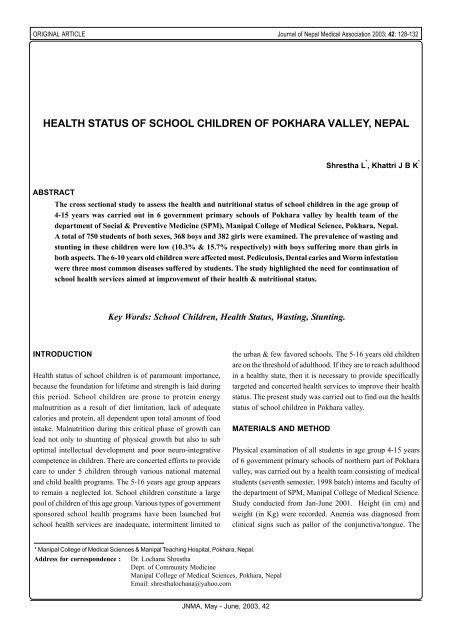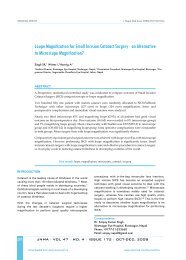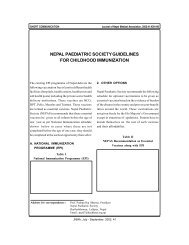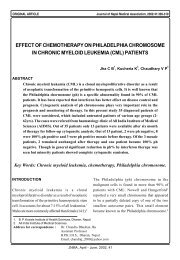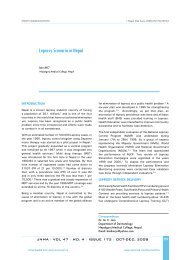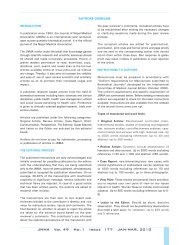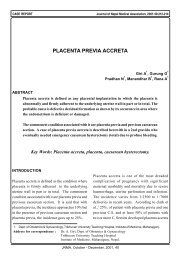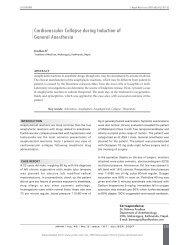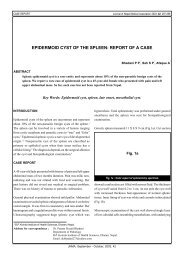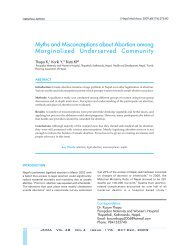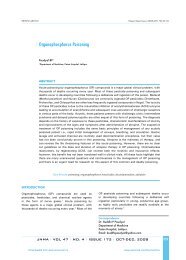health status of school children of pokhara valley, nepal - Journal of ...
health status of school children of pokhara valley, nepal - Journal of ...
health status of school children of pokhara valley, nepal - Journal of ...
You also want an ePaper? Increase the reach of your titles
YUMPU automatically turns print PDFs into web optimized ePapers that Google loves.
ORIGINAL ARTICLE <strong>Journal</strong> <strong>of</strong> Nepal Medical Association 2003; 42: 128-132<br />
HEALTH STATUS OF SCHOOL CHILDREN OF POKHARA VALLEY, NEPAL<br />
Shrestha L * , Khattri J B K *<br />
ABSTRACT<br />
The cross sectional study to assess the <strong>health</strong> and nutritional <strong>status</strong> <strong>of</strong> <strong>school</strong> <strong>children</strong> in the age group <strong>of</strong><br />
4-15 years was carried out in 6 government primary <strong>school</strong>s <strong>of</strong> Pokhara <strong>valley</strong> by <strong>health</strong> team <strong>of</strong> the<br />
department <strong>of</strong> Social & Preventive Medicine (SPM), Manipal College <strong>of</strong> Medical Science, Pokhara, Nepal.<br />
A total <strong>of</strong> 750 students <strong>of</strong> both sexes, 368 boys and 382 girls were examined. The prevalence <strong>of</strong> wasting and<br />
stunting in these <strong>children</strong> were low (10.3% & 15.7% respectively) with boys suffering more than girls in<br />
both aspects. The 6-10 years old <strong>children</strong> were affected most. Pediculosis, Dental caries and Worm infestation<br />
were three most common diseases suffered by students. The study highlighted the need for continuation <strong>of</strong><br />
<strong>school</strong> <strong>health</strong> services aimed at improvement <strong>of</strong> their <strong>health</strong> & nutritional <strong>status</strong>.<br />
Key Words: School Children, Health Status, Wasting, Stunting.<br />
INTRODUCTION<br />
Health <strong>status</strong> <strong>of</strong> <strong>school</strong> <strong>children</strong> is <strong>of</strong> paramount importance,<br />
because the foundation for lifetime and strength is laid during<br />
this period. School <strong>children</strong> are prone to protein energy<br />
malnutrition as a result <strong>of</strong> diet limitation, lack <strong>of</strong> adequate<br />
calories and protein, all dependent upon total amount <strong>of</strong> food<br />
intake. Malnutrition during this critical phase <strong>of</strong> growth can<br />
lead not only to shunting <strong>of</strong> physical growth but also to sub<br />
optimal intellectual development and poor neuro-integrative<br />
competence in <strong>children</strong>. There are concerted efforts to provide<br />
care to under 5 <strong>children</strong> through various national maternal<br />
and child <strong>health</strong> programs. The 5-16 years age group appears<br />
to remain a neglected lot. School <strong>children</strong> constitute a large<br />
pool <strong>of</strong> <strong>children</strong> <strong>of</strong> this age group. Various types <strong>of</strong> government<br />
sponsored <strong>school</strong> <strong>health</strong> programs have been launched but<br />
<strong>school</strong> <strong>health</strong> services are inadequate, intermittent limited to<br />
the urban & few favored <strong>school</strong>s. The 5-16 years old <strong>children</strong><br />
are on the threshold <strong>of</strong> adulthood. If they are to reach adulthood<br />
in a <strong>health</strong>y state, then it is necessary to provide specifically<br />
targeted and concerted <strong>health</strong> services to improve their <strong>health</strong><br />
<strong>status</strong>. The present study was carried out to find out the <strong>health</strong><br />
<strong>status</strong> <strong>of</strong> <strong>school</strong> <strong>children</strong> in Pokhara <strong>valley</strong>.<br />
MATERIALS AND METHOD<br />
Physical examination <strong>of</strong> all students in age group 4-15 years<br />
<strong>of</strong> 6 government primary <strong>school</strong>s <strong>of</strong> northern part <strong>of</strong> Pokhara<br />
<strong>valley</strong>, was carried out by a <strong>health</strong> team consisting <strong>of</strong> medical<br />
students (seventh semester, 1998 batch) interns and faculty <strong>of</strong><br />
the department <strong>of</strong> SPM, Manipal College <strong>of</strong> Medical Science.<br />
Study conducted from Jan-June 2001. Height (in cm) and<br />
weight (in Kg) were recorded. Anemia was diagnosed from<br />
clinical signs such as pallor <strong>of</strong> the conjunctiva/tongue. The<br />
* Manipal College <strong>of</strong> Medical Sciences & Manipal Teaching Hospital, Pokhara, Nepal.<br />
Address for correspondence : Dr. Lochana Shrestha<br />
Dept. <strong>of</strong> Community Medicine<br />
Manipal College <strong>of</strong> Medical Sciences, Pokhara, Nepal<br />
Email: shresthalochana@yahoo.com<br />
JNMA, May - June, 2003, 42
129 Shrestha et al. Health Status <strong>of</strong> School Children <strong>of</strong> Pokhara Valley<br />
mean weight and height <strong>of</strong> the <strong>children</strong> according to age and<br />
sex were compared with the median weight for age and height<br />
for age as per ICMR standards 1 . Nutritional <strong>status</strong> <strong>of</strong> the studied<br />
<strong>children</strong> was assessed through weight for age (wasting) and<br />
height for age (stunting) according to waterlow classification.<br />
RESULTS & DISCUSSION<br />
A total <strong>of</strong> 750 students <strong>of</strong> both sexes (368 boys and 382 girls) in<br />
the age groups <strong>of</strong> 4 years to 15 years were examined. (Table I)<br />
On an average the boys at age 7 and the girls at age 12 were<br />
found to significantly taller than the girls and boys respectively.<br />
At ages 4, 5, 6, 8 and 10 years the boys were taller than girls<br />
and in remaining ages girls were taller than boys, but these<br />
differences were statistically not significant. (Table II)<br />
On an average the girls weighed significantly more than the<br />
boys at ages 11, 12, 13 and 14. At the remaining ages the boys<br />
were weighed more than girls, but these differences were<br />
statistically not significant. (Table III)<br />
Table I : Distribution <strong>of</strong> <strong>children</strong> by age and sex<br />
JNMA, May - June, 2003, 42


